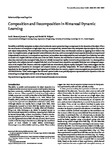Composition and Decomposition in Bimanual Dynamic Learning
| dc.contributor.author | Howard, Ian | |
| dc.contributor.author | Ingram, JN | |
| dc.contributor.author | Wolpert, DM | |
| dc.date.accessioned | 2019-10-22T12:41:30Z | |
| dc.date.available | 2019-10-22T12:41:30Z | |
| dc.date.issued | 2008-10-15 | |
| dc.identifier.issn | 0270-6474 | |
| dc.identifier.issn | 1529-2401 | |
| dc.identifier.uri | http://hdl.handle.net/10026.1/15031 | |
| dc.description.abstract |
<jats:p>Our ability to skillfully manipulate an object often involves the motor system learning to compensate for the dynamics of the object. When the two arms learn to manipulate a single object they can act cooperatively, whereas when they manipulate separate objects they control each object independently. We examined how learning transfers between these two bimanual contexts by applying force fields to the arms. In a coupled context, a single dynamic is shared between the arms, and in an uncoupled context separate dynamics are experienced independently by each arm. In a composition experiment, we found that when subjects had learned uncoupled force fields they were able to transfer to a coupled field that was the sum of the two fields. However, the contribution of each arm repartitioned over time so that, when they returned to the uncoupled fields, the error initially increased but rapidly reverted to the previous level. In a decomposition experiment, after subjects learned a coupled field, their error increased when exposed to uncoupled fields that were orthogonal components of the coupled field. However, when the coupled field was reintroduced, subjects rapidly readapted. These results suggest that the representations of dynamics for uncoupled and coupled contexts are partially independent. We found additional support for this hypothesis by showing significant learning of opposing curl fields when the context, coupled versus uncoupled, was alternated with the curl field direction. These results suggest that the motor system is able to use partially separate representations for dynamics of the two arms acting on a single object and two arms acting on separate objects.</jats:p> | |
| dc.format.extent | 10531-10540 | |
| dc.format.medium | ||
| dc.language | en | |
| dc.language.iso | eng | |
| dc.publisher | Society for Neuroscience | |
| dc.subject | learning | |
| dc.subject | dynamics | |
| dc.subject | motor control | |
| dc.subject | human | |
| dc.subject | bimanual | |
| dc.subject | arm movements | |
| dc.title | Composition and Decomposition in Bimanual Dynamic Learning | |
| dc.type | journal-article | |
| dc.type | Comparative Study | |
| dc.type | Journal Article | |
| dc.type | Research Support, Non-U.S. Gov't | |
| plymouth.author-url | https://www.webofscience.com/api/gateway?GWVersion=2&SrcApp=PARTNER_APP&SrcAuth=LinksAMR&KeyUT=WOS:000260060600008&DestLinkType=FullRecord&DestApp=ALL_WOS&UsrCustomerID=11bb513d99f797142bcfeffcc58ea008 | |
| plymouth.issue | 42 | |
| plymouth.volume | 28 | |
| plymouth.publication-status | Published | |
| plymouth.journal | The Journal of Neuroscience | |
| dc.identifier.doi | 10.1523/jneurosci.3473-08.2008 | |
| plymouth.organisational-group | /Plymouth | |
| plymouth.organisational-group | /Plymouth/Faculty of Science and Engineering | |
| plymouth.organisational-group | /Plymouth/Faculty of Science and Engineering/School of Engineering, Computing and Mathematics | |
| plymouth.organisational-group | /Plymouth/REF 2021 Researchers by UoA | |
| plymouth.organisational-group | /Plymouth/REF 2021 Researchers by UoA/UoA11 Computer Science and Informatics | |
| plymouth.organisational-group | /Plymouth/Users by role | |
| plymouth.organisational-group | /Plymouth/Users by role/Academics | |
| dc.publisher.place | United States | |
| dc.identifier.eissn | 1529-2401 | |
| dc.rights.embargoperiod | Not known | |
| rioxxterms.versionofrecord | 10.1523/jneurosci.3473-08.2008 | |
| rioxxterms.licenseref.uri | http://www.rioxx.net/licenses/all-rights-reserved | |
| rioxxterms.type | Journal Article/Review |


